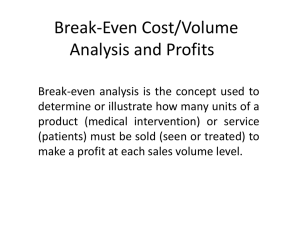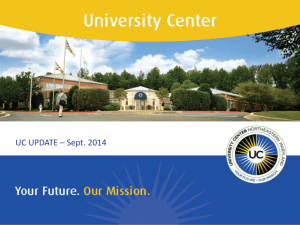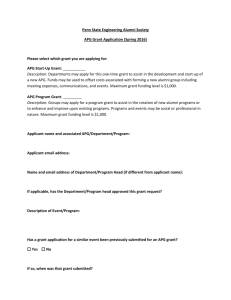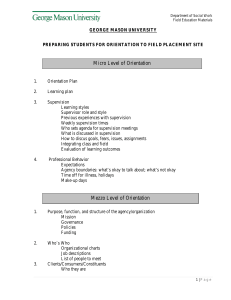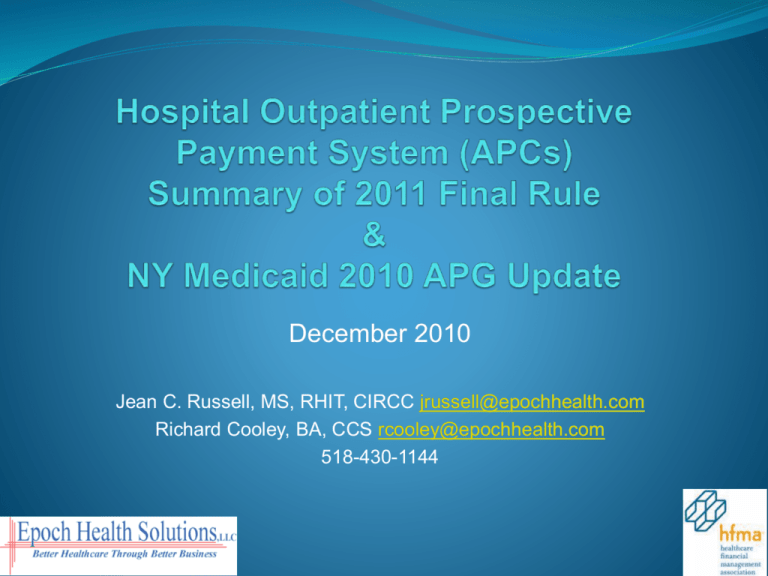
December 2010
Jean C. Russell, MS, RHIT, CIRCC jrussell@epochhealth.com
Richard Cooley, BA, CCS rcooley@epochhealth.com
518-430-1144
2
Agenda
•
•
Reimbursement Impact
Policy Changes
•
•
•
•
•
•
•
•
•
Preventative Services
Physician-owned Facilities
GME/IME Provision Changes
Physician Supervision Rules
Cardiology Changes
Drugs, Drug Payment and Administration
Other Changes
Hospital Data Quality Indicators
NY Medicaid APG Update
3
Abbreviations
ASP – Average Sales Price
AWV - Annual Wellness Visit
CMHC – Community Mental Health Center
MPFS – Medicare Physician Fee Schedule
NPP – Non-Physician Practitioners
PBD – Provider-based Department
PHP – Partial Hospitalization Program
PPACA/ACA - Patient Protection and Affordable Care Act 2010
PPPS - Personalized Prevention Plan Services
USPSTF – US Preventative Services Task Force
4
APC Reimbursement
5
Payment Impact
Hospitals that met the quality indicator reporting
requirements will get the full 2.35% increase
Reflects market-basket update of 2.6% less 0.25%
reduction required by PPACA
2.0% reduction in payment update factor if hospital did
not meet the quality indicator reporting requirements
Compared to 2.1% increase in 2009
Conversion factor:
$68.876 - Met quality reporting standards
6
Outlier Calculations
Calculation methodology unchanged
1st Threshold:
Line-item cost exceeds 1.75 times APC payment
2nd Threshold:
Line-item cost exceeds APC payment plus $2,025
Down from $2,175 last year
When both thresholds met
Outlier payment = 50% * Cost – 1.75 * APC payment
50% of the cost that exceeds 1.75 times APC payment
[cost = charges * RCC]
7
Hold Harmless TOPs
Existing hold-harmless transitional outpatient
payments (TOPs) paid to rural hospitals and Sole
Community Hospitals with 100 or fewer beds expires
at the end of the year
CMS does not have the authority to extend these
payments without legislation
AMA and HANYS are both urging Congress to pass
legislation to extend this provision.
8
Deductible Changes
Inpatient deductible will increase from
$1100 to $1132
Outpatient deductible will increase form
$155 to $162
9
Partial Hospitalization
Continue two-tiered payment approach
But created separate rates for CMHCs and
Hospitals
Rates based on the number of services
provided each day
A rate for 3 services
A separate rate for 4 or more services
10
Partial Hospitalization
CMHC - Per diem rates
APC 172 Level I Partial Hospitalization
3 services
$130 - per diem
APC 173 Level II Partial Hospitalization
4 or more services
$164 - per diem rate
Rates based on a two year transition period for
CMHCs
11
Partial Hospitalization
PHP - Per diem rates
APC 175 Level I Partial Hospitalization
3 services
$205 - per diem
APC 176 Level II Partial Hospitalization
4 or more services
$238 - per diem rate
12
APC Status Indicators
No changes to any Status Indicators
Review of the Composite Status Indicators:
“Q1” - “STVX-packaged codes”
“Q2” - “T-packaged codes”
“Q3” – Procedure codes that may be paid
through a composite APC based on
composite-specific criteria or separately
through single code APCs when composite
criteria is not met
13
Original Composite APCs
1. Mental Health Services – Partial
Hospitalization
2. Low dose prostate brachytherapy
3. Cardiac EP (electrophysiologic) evaluation and
ablation services
4. Extended ED observation and monitoring
5. Extended Clinic observation and monitoring
14
Multiple Imaging Services
Added in 2009 for five imaging composite APCs
Single APC payment for two or more imaging
procedures provided using same imaging modality
The imaging composite APCs are:
1.
2.
3.
4.
5.
Ultrasound
CT and CTA w/o contrast
CT and CTA with contrast
MRI and MRA w/o contrast
MRI and MRA w/contrast
15
Services Performed
During Critical Care
Services listed in the CPT® book that are
included in critical care when performed
during the critical period
Example chest x-ray
These services should not be reported
separately in CY 2010 and prior years for
hospitals and physicians
16
Services Performed During
Critical Care
Effective for 2011 these ancillary services can be
reported when provided in conjunction with critical
care services
These services are now assigned a status indicator
of Q3 (composite)
They will be conditionally packaged when performed
with a 99291 (critical care)
17
Policy Changes
18
Preventative Services
No coinsurance or copayment for certain preventive
services recommended by the USPSTF
Personalized Prevention Plan Services (PPPS) are
excluded from payment under the OPPS
Annual Wellness Visits (AWV) that provide PPPS will
be paid on the Physician Fee Schedule
CMS will pay for either the practitioner or the facility for
the AWV provided in a facility setting
Only a single payment will be allowed (no split)
19
Preventive Services
Services with deductible and coinsurance waived:
Vaccines: Pneumococcal, Influenza and Hepatitis B
Screening Mammography
Screening pap smear and pelvic exams
Some Colorectal Cancer screening tests
Bone Mass Measurement
Medical Nutrition Therapy
Cardiovascular Screening blood tests
Ultrasound screening for abdominal aortic aneurysm
Smoking and Tobacco Cessation
TABLE 48B – LIST OF HCPCS CODES
RECOGNIZED AS PREVENTATIVE SERVICES
20
Preventative Services
Services not covered:
Glaucoma Screening
Prostate Screening
Some Colorectal Cancer Screening
ECG for the Initial Preventative Physical Exam
21
Preventive Services
Deductible is waived for colorectal cancer screening
tests that become diagnostic
All surgical services on the same date as a
colorectal screening will be part of the same clinical
encounter and have no deductible
A new HCPCS modifier will be appended to the code
when the screening becomes diagnostic
New Modifier: PT – Colorectal cancer screening test
converted to diagnostic test or other procedure
22
Preventative Services
90658 – no longer payable under OPPS
Replaced by Influenza virus vaccine, split virus, 3+
years:
Q2035 – afluria
Q2036 – flulaval
Q2037 – fluvirin
Q2038 - fluzone
Q2039 - NOS
23
Preventative Services
The AWV is reported with two new HCPCS
codes effective January 1, 2011 – APC Status
Indicator A:
G0438 – Annual wellness visit, including
PPPS, first visit
G0439 – Annual wellness visit, including
PPPS, subsequent visit
24
Physician-Owned Facilities
For the more than 200 physician-owned hospitals
across the US:
The ACA prohibits the development of new
physician-owned hospitals
And expansion of existing physician-own hospitals
There must be a provider agreement in effect by the
end of 2010
25
Direct/Indirect Graduate
Medical Education Changes
New provision from the ACA redistributes unused
residency slots
CMS required to identify unused residency slots and
redistribute them to certain hospitals w/ qualified
residency programs
Priority will be given to hospitals in a state with a
resident-to-populations ratio in the lowest percentile
(not New York)
Goal is to increase the number of primary care
physicians
26
Direct/Indirect Graduate
Medical Education Changes
Specifies how hospitals should count residency
hours for certain training and research activities
and patient care in physician offices
CMS will count time spent by residents in a non-
provider setting toward direct GME (DGME) and IME
costs if the hospital incurs the costs of resident
salaries and fringe benefits
CMS will count resident time spent in certain nonpatient care activities while training for DGME
purposes
27
Physician Supervision
28
Key 2011 Changes
Changed the definition of “immediately available”
Created a list of Extended Duration services that
require “direct supervision” for the beginning,
followed by “general supervision” for the remainder
Extended CAH and added Rural Hospitals to the
exception to the supervision rules required for
Therapeutic services
Plans to convene a panel beginning in 2012 to
determine the level of supervision required for
different services
29
Physician Supervision
Three levels of supervision in the hospital
outpatient setting have been defined as:
General – Overall direction of physician, but
presence is not required during the
performance
Direct – Physician is present on-site and
“immediately” available if needed
Personal – Physician is present in the room
30
Physician Supervision of
Therapeutic Services
Outpatient Therapeutic Services
“Direct Supervision” required for outpatient hospital
and HBD paid by Medicare
“We assume the physician requirement is met on
hospital premises because staff physicians would
always be nearby within the hospital. The effect of the
regulations in this final rule is to extend this
assumption to a department of a hospital that is
located on the campus of the hospital”
As clarified in CY 2009 OPPS Final Rule
31
Changed Definition of
Direct Supervision
Removed the reference to “on the same campus” or
“in the off-campus provider-based department of the
hospital” and removed the definition of “in the
hospital or CAH”
Revised – “Direct supervision means that the
physician or NPP must be immediately available to
furnish assistance and direction throughout the
performance of the procedure.”
There is no longer any reference to the particular
physical boundary
32
Changed Definition of
Direct Supervision
Allows greater flexibility in providing for direct
supervision from a location other than the hospital or
HBD campus
33
NPP Supervision of OP Tx Services
CMS will allow certain non-physician
practitioners (NPP) to provide direct supervision
for all therapeutic services
Services must be those they are authorized to
personally perform according to their state scope
of practice rules and hospital-granted privileges:
NP, PA, certified nurse mid-wives, clinical
nurse specialists, licensed clinical social
workers, clinical psychologists
34
Non-Surgical Extended Duration
Therapeutic Services
“Extended Duration Services”
Direct supervision required for the
initiation of the service, followed by
general supervision for the remainder of
the service
“Initiation of the service”
Beginning portion that ends when the
patient is stable
35
Extended Duration Services
Tx Service must be extended duration
2. Service must consist largely of
significant monitoring
3. Service must be sufficiently low risk
4. Service cannot be surgical
Includes – Observation
Excludes – Chemotherapy/Blood
Transfusions
1.
TABLE 48A – LIST OF NONSURGICAL EXTENDED
DURATION THERAPEUTIC SERVICES
36
Physician Supervision –
of Diagnostic Services
Medicare Physician Fee Schedule Relative Value
File – Indicator, for example:
01 = Procedure must be performed under the general
supervision of a physician
02 = Procedure must be performed under the direct
supervision of a physician
03 = Procedure must be performed under the personal
supervision of physician
[https://www.cms.gov/PhysicianFeeSched/PFSRVF/list.asp#TopOfPage]
37
Examples
02 – Direct Supervision of a Physician
77058 and 77059 – MRI of the breast
93282-93284 – ICD device program evaluation
01 – General Supervision of a Physician
59025 – Fetal non stress test
72192 – CT of the pelvis w/o dye
38
Physician Supervision –
of Diagnostic Services
MPFS supervision indicator explicitly applies to
hospitals
Paid in accordance with Section 1833 of the Act
This is the section that is the OPPS Authority
Does not apply to CAHs
Paid in accordance with Section 1834 of the Act
Therefore CAHs are not subject to this supervision
requirement
39
Diagnostic Tests
NPPs cannot function as supervisory
“physicians” for diagnostic testing
Must follow the supervision requirements
as listed in the MPFS
40
CAH CoP
CAH CoPs recognize the statutory authority to be
staffed by NPPs rather than physicians, provided a
MD or OD, NP, PA or clinical nurse specialist is
available to provide care at all times the CAH
operates.
That is, they are on call and immediately available by
phone and able to be on-site within 30 minutes
However, “CoPs apply largely at the facility level,
while payment regulations apply at the service level.”
41
CAH Exception to Rule
CMS issued a statement on March 15,
2010 indicating that they would not enforce
the rules for direct supervision of outpatient
therapeutic procedures performed in CAHs
in CY 2010.
They have extended this statement for CY
2011.
42
Small Rural Hospitals
Increased the scope to include small rural
hospitals
100 or fewer beds
Geographically located in a rural areas or
paid through OPPS with a wage index for a
rural area
43
Cardiology and
Endovascular
Revascularization Coding
Changes
44
Cardiology Changes
Cardiac Catheterization: 19 non-congenital codes
have been deleted and 20 new codes have been
created:
Two are new code families for cardiac
catheterizations: one for congenital heart disease and
one for all others
One new code for the administration of a
pharmacological agent during a cardiac cath
One new code for an exercise study during a cardiac
catheterization
45
Cardiology Changes
Previous multiple code reporting has been replaced
by single code reporting for diagnostic
catheterization procedures, other than the congenital
heart disease cardiac caths:
Left heart cath used to require multiple codes - 93510,
93543,93555. For 2011, report 93452 only
Imaging supervision, interpretation and report and
injection is now included in the code 93452
46
Cardiology Code Changes
TABLE 11.—CY 2009 CODE COMBINATIONS, FREQUENCIES, AND
SIMULATED MEDIAN COSTS FOR NEW CY 2011 CARDIAC
CATHETERIZATION-RELATED CODES
47
Endovascular Revascularization
of the Lower Extremity
16 new codes for endovascular revascularization of the
lower extremity - Table 6 lists the new codes
Table 7 lists the old combination of codes
Many of the new codes were reported with a combination
of old codes
Per the CPT® book the codes are inclusive of accessing
and selective catheterizing the vessel, related radiology
S&I, embolic protection, closure and imaging to
document the completion of the procedure
TABLE 6. NEW ENDOVASCULAR REVASCULARIZATION CPT
PROCEDURE CODES EFFECTIVE JANUARY 1, 2011
48
Drugs, Drug Payment and
Administration
49
2010 Drug Threshold
Keeping with the $5 per year increase
Drugs with a cost greater than $70 per day
will be paid separately
Cost calculation includes acquisition and
pharmacy overhead
Calculated costs less than $70 per day will
be packaged
50
Pass-Through Drugs
Eighteen pass-through drugs and biologicals will
expire (FR Table 27)
Five became status N
Thirteen became status K
Forty-two pass-through drugs and biologicals for
2011 (FR Table 28)
Thirty-six from 2010
Fifteen changed HCPCS codes
Six new drugs
51
New Pass-through Drugs
CY 2011
HCPCS
Code
C9274
CY 2011 Long Descriptor
Crotalidae polyvalent immune fab (ovine),
1 vial
Final
CY 2011 Final CY
SI
2011 APC
G
9274
C9275
Injection, hexaminolevulinate
hydrochloride, 100 mg, per study dose
G
9275
C9276
Injection, cabazitaxel, 1 mg
G
9276
C9277
Injection, alglucosidase alfa (Lumizyme), 1
mg
G
9277
C9278
Injection, incobotulinumtoxin A, 1 unit
G
9278
C9279
Injection, ibuprofen, 100 mg
G
9279
52
HCPCS Changes Pass-through Drugs
CY 2010
HCPCS
Code
CY 2011
HCPCS
Code
C9255
C9256
C9258
C9259
C9260
C9261
C9263
C9264
C9265
C9266
J2426
J7312
J3095
J9307
J9302
J3357
J1290
J3262
J9315
J0775
C9267 J7184
C9268
C9269
C9271
Q2025
J7335
J0597
J3385
J8562
CY 2011 Long Descriptor
Injection, paliperidone palmitate, extended release, 1 mg
Injection, dexamethasone intravitreal implant, 0.1 mg
Injection, telavancin, 10 mg
Injection, pralatrexate, 1 mg
Injection, ofatumumab, 10 mg
Injection, ustekinumab, 1 mg
Injection, ecallantide, 1 mg
Injection, tocilizumab, 1 mg
Injection, romidepsin, 1 mg
Injection, collagenase clostridium histolyticum, 0.01 mg
Injection, von Willebrand factor complex (human), Wilate, per 100 IU
VWF: RCO
Capsaicin 8% patch, per 10 square centimeters
Injection, C-1 Esterase inhibitor (human), Berinert, 10 units
Injection, velaglucerase alfa, 100 units
Fludarabine phosphate, oral, 10 mg
Final CY Final CY
2011 SI 2011 APC
G
9255
G
9256
G
9258
G
9259
G
9260
G
9261
G
9263
G
9624
G
9625
G
1340
G
9267
G
9268
G
9269
G
9271
G
1339
53
Drug Payment
Pass-through drugs paid at average sales
price (ASP) + 6%
Non-packaged, non-Pass-through drugs
paid at ASP + 5%
54
Nuclear Medicine and FB Modifier
No-cost diagnostic radiopharmaceuticals that are
provided at no cost must be reported with FB
Modifier
For Nuclear Medicine Scans listed in Table 29
(FR)
Twenty-two APCs listed in Table 29
Posted annually on the CMS Web site at
http://www.cms.gov/HospitalOutpatientPPS a file that
contains the APC offset amounts
55
Oral Antiemetics
“The majority of commenters opposed the
proposal to continue the CY 2010 policy of
no longer exempting the oral and injectable
forms of 5-HT3 antiemetics from the
packaging threshold.” 2011 FR
Translation: The majority of commenters want 5-HT3
antiemetics to be paid
CMS Response: 5-HT3 antiemetics will continure
to be packaged
56
Drug Administration
No major changes
Continue to reimburse using the five-level
APC structure for drug administration
services
57
Other Changes
58
Chemistry Drug Screening
New drug testing codes for 2011
80104—DRUG SCREEN, QUALITATIVE; MULTIPLE DRUG CLASSES
OTHER THAN CHROMATOGRAPHIC METHOD, EACH PROCEDURE
G0434—DRUG SCREEN, OTHER THAN CHROMATOGRAPHIC; ANY
NUMBER OF DRUG CLASSES, BY CLIA WAIVED TEST OR MODERATE
COMPLEXITY TEST, PER PATIENT ENCOUNTER
Description
Drug Screen Qual Multi-Class Chromatography
Medicare
80100
Other Payer
Drug Screen Qual Multi-Class Not Chromatography
G0434
80104
Drug Screen Qual Single Class
G0431
80101
Drug Confirmation Each
80102
59
E/M Technical Levels
No national visit technical reporting guidelines
Continue to use hospital internal guidelines
New Vs Established guidelines not changed
Established – “registered” patient at the hospital w/in
the past three years
CMS encourages RACs and MACs to review
hospital internal guidelines when performing
audits
Currently there are no RAC activities involving visit
levels
60
“Triage-Only” Visit
CMS does not specify the type of hospital staff who
may provide services
“Billing a visit code in addition to another service
merely because the patient interacted with hospital
staff … is inappropriate. A hospital may bill a visit
code based on the hospital’s own coding guidelines
which must reasonably relate the intensity of hospital
resource to different levels of HCPCS codes.
Services furnished must be medically necessary and
documented.”
61
Hospital Technical Guidelines
Continues to be critical that hospital
develop and follow and audit against their
own technical E/M guidelines
For both the emergency department
Type B emergency departments (“fast
trak”)
And hospital based clinics
62
Changes to Inpatient-Only List
Criteria for removing from IP-only list
Most outpatient departments are equipped to
provide the services to the Medicare population
The simplest procedure described by the code
may be performed in most outpatient
departments
63
Criteria for Change
The procedure is related to codes that have
already been removed from the inpatient list
A determination is made that the procedure is
being performed in numerous hospitals on an
outpatient basis
A determination is made that the procedure can
be appropriately and safely performed in an ASC
64
Changes to Inpatient-Only List
Removing three procedures from the inpatient list
CPT Code
Long Descriptor
CY 2011 APC
Assignment
CY 2011 Status
Indicator
21193
Reconstruction of mandibular rami; horizontal,
vertical, C, or L osteotomy; without bone graft
0256
T
21395
Open treatment of orbital floor blowout fracture;
periorbital approach with bone graft (includes
obtaining graft
0256
T
25909
Amputation, forearm, through radius and ulna;
reamputation
0049
T
65
Align Physician Payment
with Hospital Payment?
Comment
Other commenters stated that physician’s payment should be
aligned with the hospital payment; if the hospital is not paid,
then the physician payment should not be allowed.
Response
…payment for physicians’ services are outside of the scope of
the OPPS payment policy and of this OPPS/ASC final rule with
comment period.
…we continue to believe that education is critical… we expect
hospitals to use this knowledge and to educate physicians with
regard to the appropriate setting for the procedures they
furnish.
66
Pass-through Device
One new pass-through device (status H)
October, 2010
C1749– Endoscope retrograde
imaging/illumination colonoscope device
(implantable)
Pass-through device list updated quarterly
67
Brachytherapy Sources
APC status indicator U
Continue to be paid on APCs based on
cost
FR Table 37 provides details
Continue to be subject to outlier payment
provision
68
No Cost/Full Credit and
Partial Credit Devices
Background
Affects payment for recalls of devices as a result
of failures
Manufacturers have offered devices without
cost to the hospital
Ensure that payment rates for procedures
involving devices reflect only the full costs of
those devices
69
Full and Partial Offset
Reduce OPPS payment for specified APCs
100 % (FB modifier) of the device offset
amount when a hospital furnishes a specified
device without cost or with a full credit
50 % (FC modifier) of the device offset amount
when the hospital receives partial credit in the
amount of 50 percent or more of the cost for
the specified device
70
APC Changes for 2011
Criteria to continue for 2011
Affects Surgical APCs that use an implantable
device
Devices must remain in the body (at least
temporarily)
Device off-set must be at least 40% of APC
cost.
Adjustment is made (based on FB or FC
modifier) when APC is in Table 26, and device is
in Table 25 (provided in OPPS Final Rule).
71
Changes for 2011
APC Changes for 2011
Added APC 318 (Implatation of Cranial
Neurostimulator Pulse Generator and
Electrode)
Deleted APC 225 (Implantation of
Neurostimulator Electrodes, Cranial Nerve)
No changes to the Device List (Table 26)
72
Hospital Outpatient Quality Data
Reporting Program (HOP
QDRP)
73
Background
Allows financial incentive based on quality
control measures
Modeled after the inpatient program
(RHQDAPU), but unique to hospital outpatient
services
HOP QDRP implemented in 2008, affected the
payment rate update for 2009
Affects CY OPPS payment update—2.0 % point
reduction in rate increase
74
Financial Penalty
Impacts APC paid services
Lose 2% of 2.35% (2011 market-basket
increase) of APC rate
Study of one 300+ bed hospital
Impact equal to $21,800
75
Seven Original Measures
Affected payment update for 2009
Five based on Emergency Department (ED) AMI
(acute myocardial infarction) measures
Chart-based abstractions
OP–1: Median Time to Fibrinolysis
OP–2: Fibrinolytic Therapy Received Within 30
Minutes
OP–3: Median Time to Transfer to Another Facility for
Acute Coronary Intervention
OP–4: Aspirin at Arrival
OP–5: Median Time to ECG
76
Seven Original Measures
Two based on Perioperative Care measures
OP–6: Timing of Antibiotic Prophylaxis
OP–7: Prophylactic Antibiotic Selection for
Surgical Patients
77
Added Four Imaging Efficiency
Measures
Affected payment update for 2010
Based on Part B claims data
OP–8: MRI Lumbar Spine for Low Back Pain
OP–9: Mammography Follow-up Rate
OP–10: Abdomen CT—Use of Contrast
Material
OP–11: Thorax CT—Use of Contrast Material
78
2011 Continues with Eleven
Hospitals will report on the same eleven measures in
2010 to receive full market basket increase in 2011
Details and updates can be followed on QualityNet
website:
http://www.qualitynet.org/dcs/ContentServer?c=Page
&pagename=QnetPublic%2FPage%2FQnetTier2&ci
d=1196289981244
79
CY 2012 Payment Determination
Twelve of the sixteen new measures
proposed in 2010 OPPS Rule will be
adopted for 2012 and 2013
Four new measures reported for 2011
(affecting 2012 update)
Eight new measures reported for 2012
(affecting 2013 update)
80
CY 2012 Payment Determination
1. OP-12: The Ability for Providers with HIT to Receive
Laboratory Data Electronically Directly into their
Qualified/Certified EHR System as Discrete Searchable
Data
2. OP- 13: Cardiac Imaging for Preoperative Risk
Assessment for Non-Cardiac Low-Risk Surgery
3. OP-14: Simultaneous Use of Brain Computed
Tomography (CT) and Sinus Computed Tomography
(CT)
4. OP-15: Use of Brain Computed Tomography (CT) in the
Emergency Department for Atraumatic Headache
81
CY 2013 Payment Determination
1. OP-16: Troponin Results for Emergency Department
acute myocardial infarction (AMI) patients or chest pain
patients (with Probable Cardiac Chest Pain) Received
Within 60 minutes of Arrival Immunization
Pneumococcal vaccination status Influenza vaccination
status
2. OP-17: Tracking Clinical Results between Visits
3. OP-18: Median Time from ED Arrival to ED Departure
for Discharged ED Patients
4. OP-19: Transition Record with Specified Elements
Received by Discharged Patients
82
CY 2013 Payment Determination
5. OP-20: Door to Diagnostic Evaluation by a
Qualified Medical Professional SPECT MPI and
stress echocardiography for preoperative
evaluation
6. OP-21: ED- Median Time to Pain Management for
Long Bone Fracture
7. OP-22: ED- Patient Left Before Being Seen
8. OP-23: ED- Head CT Scan Results for Acute
Ischemic Stroke or Hemorrhagic Stroke who
Received Head CT Scan Interpretation Within 45
minutes of Arrival
83
CY 2014 Payment Determination
Will retain the twenty-three from 2013
Propose six more, but not finalized
1.
2.
3.
4.
5.
6.
Hemoglobin A1c Poor Control in Diabetic Patients
Low Density Lipoprotein (LDL-C) Control in Diabetic
Patients
High Blood Pressure Control in Diabetic Patients
Dilated Eye Exam in Diabetic Patients
Urine Screening for Microalbumin or Medical Attention for
Nephropathy in Diabetic Patients
Exposure Time Reported for Procedures Using
Fluoroscopy
84
Quality Reporting Validation
Beginning with CY 2012 payment determination
800 hospitals would be selected randomly (approximately 20
percent of all participating HOP QDRP hospitals) each year
Randomly select up to 48 self reported cases from the total
number of cases (12 per quarter)
CMS contractor would request paper copies of medical
documentation corresponding to selected cases
CMS contractor would verify that quality data submitted is
accurate
Hospitals must attain at least a 75 percent validation score to
receive the full OPPS update in CY 2012
85
Results to be Published
Data will be published on
http://www.hospitalcompare.hhs.gov
Data will be made public after a
preview period
86
NY Medicaid APG Update
87
Hospital OP Dept
Blended Rate 75% 1/1/2011
88
Medical Visits Will No Longer Package With
Higher Intensity Significant Ancillaries
Effective January 1, 2010 Medical visits will no
longer package with:
more significant ancillaries (e.g., MRIs, mammograms,
CAT scans, etc.)
dental procedures
PT, OT, and speech therapies; and
counseling services
In these cases, a coded medical visit will separately
pay at the line level
89
Significant Procedure APGs With Which
Medical Visits Do Not Package
Modifier 25 will be emulated by grouper on all
lines grouping to APG 491 (MEDICAL VISIT)
when one of these APGs is coded
List found at:
http://www.health.state.ny.us/health_care/medica
id/rates/apg/docs/apg_not_package.pdf
Does not include surgical type procedures
90
D&TCs
Implementation of ancillary billing policy
will be delayed a second time, until April 1,
2011
Lab and radiology services will continue to
be paid on the Medicaid fee schedule
91
Medicaid Secondary
For Medicaid recipients who are also covered by
Medicare or commercial insurance
Hospital will continue to use old visit code 1400 for
monthly billings of Medicare co‐pays and deductibles
for dual eligible enrollees
If the lab or radiology provider is required to bill
Medicare or the commercial insurance directly, the
lab/radiology provider should do so
The lab/radiology provider should then bill Medicaid for
the balance due
The clinic should not report these ancillary
lab/radiology services on their APG claim
92
New Weights and Rates
APG weights and base rates have been
updated – last published update
September 2010
Located at :
http://www.health.state.ny.us/health_care/
medicaid/rates/apg/index.htm#rates
93
Carve Outs
Updated regularly– next update 1/1/2011
http://nyhealth.gov/health_care/medicaid/rates/a
pg/docs/apg_carve_outs.pdf
Inclusion on this list indicates that service should
not be billed using APGs, since it does not
guarantee alternative payment
MRIs no longer carved‐out of the threshold visit,
but instead must be billed under APGs
New “premium” drug carve outs added
94
New Premium Drug “Class VII” APG
New (1/1/2010) “premium” drug APG, consisting of
certain chemotherapy and pharmacotherapy drugs
All drugs grouping to this class will be carved out of
APGs and billable to the Ordered Ambulatory Fee
Schedule
95
Capital Add-ons
Ancillary-only and dental examination visits will
receive capital add-on payments (January 2010)
Still no capital add-on payment for visit types:
Medication Administration and Observation only
Physical Therapy, group
Speech Therapy, group
Cardiac Rehabilitation
Immunization
Patient Education
96
Pre-Surgery Testing
How to bill pre‐surgical testing for ambulatory
surgery:
When ordered by an OPD or D&TC clinic practitioner
for a clinic patient during an APG reimbursable clinic
visit
Bill using an APG rate code
When ordered by a hospital ambulatory surgery unit or
ambulatory surgery center practitioner for a patient
referred to the ambulatory surgery facility
Bill by the ancillary provider on an ordered ambulatory basis
using the Medicaid fee schedule
97
Post-Surgery Testing
All post‐surgical tests, e.g., pathology,
ordered by the hospital ambulatory
surgery unit or ambulatory surgery
center practitioner should be billed by
the ancillary provider on an ordered
ambulatory basis using the Medicaid
fee schedule
98
Inpatient Only Services
Not reimbursed under the APG payment
methodology
The APG Grouper will automatically reject
these procedures for payment
Will be paid through the Inpatient All
Patient Refined ‐Diagnosis Related Groups
(APR‐DRG) payment methodology
99
Inpatient Only List
The State's APG Inpatient Only List" is different
from CMS' APC "Inpatient Only List"
Providers will need to maintain two lists--one for
APCs and one for APGs
The APG list allows for more procedures on an
outpatient basis
List is available at:
www.nyhealth.gov/health_care/medicaid/rates/apg/doc
s/inpatient_only.pdf
100
Cardiac Rehabilitation
The no‐blend APG list now includes cardiac
rehabilitation, which came off the “never
pay” APG list (1/1/2010)
101
HIV/AIDs Counseling/Testing
Effective January 2011 these rates codes in hospital
OPDs (2893, 3111, 3109) and DT&Cs (1695, 1802,
3109) will be subsumed into the APG system
Will then be paid based on procedures and primary
diagnosis code
Should start to report with the APG access rate
codes (e.g., 1400, 1407 or 1432)
Details can be found at:
http://www.health.state.ny.us/health_care/medicaid/r
ates/apg/docs/procedure_code_guidance.pdf
102
Mental Health APGs
Codes for Mental Health APGs implemented
10/1/2010
Significant change in how these services are
reported
However, the services are not yet being paid under
APGs
Still reported with the pre-APG rate codes
Awaiting CMS approval for implementation
Expect an update at the HANYS webinar Friday
103
Known Issue List
Lists known issues, changes and other significant
information
Regularly updated
Includes situations where claims need to be
resubmitted for appropriate reimbursement
For example – July 2010 grouper included a fix for
2009 E/M and Significant procedure unpaid claims
submitted between April and July 1010 – these
claims need to be resubmitted for appropriate
reimbursement
104
2011 APG Update
HANYS and the Greater New York Hospital
Association Webconference APGs - Friday,
December 17, from 3 to 5 p.m
2011 changes and related APGs issues:
Base rate changes
APG logic changes for January 2011
Mental health APGs
Ancillary billing policy
The state plan amendment
105
Questions and Discussion
106
Contact Us
Richard Cooley
Phone:
Email:
518-430-1144
rcooley@epochhealth.com
Jean Russell
Phone:
Email:
518-369-4986
jrussell@epochhealth.com
107
http://www.EpochHealth.com/
108
CPT®
Current Procedural Terminology (CPT®)
Copyright 2010 American Medical
Association
All Rights Reserved
Registered trademark of the AMA
109
Survey Link
Please take a moment to provide feedback on
today’s education session:
http://www.surveymonkey.com/s/APC_Final_Rule_S
ummary_APG_Update
110
Disclaimer
Information and opinions included in this
presentation are provided based on our
interpretation of current available regulatory
resources. No representation is made as to the
completeness or accuracy of the information. Please
refer to your payer or specific regulatory guidelines
as necessary.


